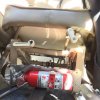Tom-D
Taxi to Parking
- Joined
- Feb 23, 2005
- Messages
- 34,740
- Display Name
Display name:
Tom-D
Ah... so you could bolt the seat to the floor and climb over it to get in, and the FAA would still think an inspection was needed.
Yup, sounds like the agency we've all come to know and love...
I feel safer already.
The only seat track AD you will ever see is the one the company lawyers asked for when they try to sell parts.
You use words like Safety, Emergency, or Hazard to flight, when you ask for an AD and the FAA will rubber stamp the request, because they go with the idea you know your product better than they do.
Cessna did this when they got sued over a seat slippage accident in a C-185.
Precision Airmotive did this when they screwed up the Marvel carb.










